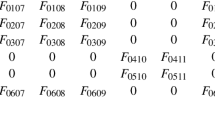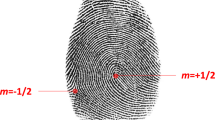Abstract
The static and evolutionary properties of two-dimensional cellular structures, or froths, are discussed in the light of recent work on structuring of the froth into concentric shells. Of interest is the dual role of a topological dislocation (“defect”) in an otherwise uniform froth, considered both as a source of disorder and also as a source generating a shell-structured froth. We present simulations on an initially uniform hexagonal froth. A defect is introduced by forcing either a T1 or T2 process in the stable structure, after which the froth is allowed to evolve according to von Neumann's law. In the first case, topological inclusions are found in the first few layers early in the evolution. In the second case, no inclusions appear over the entire evolutionary period. The growing disorder (as measured by the second moment of the side distribution, μ 2) is isotropic. For the special case of a T2-formed froth in a uniform network, the SSI structure is retained with μ 2≠0 only for the zeroth, first, and second layers. The ratio between topological perimeter and radius of the shells is close to 6, the value for a hexagonal froth.
Similar content being viewed by others
REFERENCES
A. Abdelkader and J. C. Earnshaw, Phys. Rev. E 56:3251 (1997).
D. A. Aboav, Metallography 3:383 (1970).
T. Aste, Foams and Emulsions, J. F. Sadoc and N. Rivier, eds. (Kluwer, 1997).
T. Aste, D. Boose, and N. Rivier, Phys. Rev. E 53:6181 (1996a).
T. Aste, K. Y. Szeto, and W. Y. Tam, Phys. Rev. E 54:5482 (1996b).
T. Aste and N. Rivier, in Shape Modelling and Applications (IEEE Computer Society Press, 1997), pp. 2–9.
B. N. Boots, Metallography 15:53 (1982).
B. Dubertret, N. Rivier, and M. A. Peshkin, J. Phys. A: Math. Gen. 31:879 (1998).
J. A. Glazier, S. P. Gross, and J. Stavans, Phys. Rev. A 36:306 (1987).
Y. Jiang, J. C. M. Mombach, and J. A. Glazier, Phys. Rev. E 52:R3333 (1995).
B. Levitan, Phys. Rev. Lett. 72:4057 (1994).
B. Levitan, E. Slepyan, O. Krichevsky, J. Stavans, and E. Domany, Phys. Rev. Lett. 73:756 (1994).
B. Levitan and E. Domany, Phys. Rev. E 54:2766 (1996).
F. T. Lewis, Anat. Rec. 38:341 (1928).
H. M. Ohlenbusch, T. Aste, B. Dubertret, and N. Rivier, Eur. Phys. J. B 2:211 (1998).
M. A. Peshkin, K. J. Strandburg, and N. Rivier, Phys. Rev. Lett. 67:1803 (1991).
N. Rivier, Foams and Emulsions, J. F. Sadoc and N. Rivier, eds. (Kluwer, 1997).
N. Rivier and T. Aste, Phil. Trans. Roy. Soc. A 354:2055 (1996).
H. J. Ruskin and Y. Feng, J. Phys.: Condens. Matter 7:L553 (1995).
H. J. Ruskin and Y. Feng, Physica A 230:455 (1996).
H. J. Ruskin and Y. Feng, Physica A 247:153 (1997).
J. Stavans, Rep. Prog. Phys. 56(6):733 (1993).
K. Y. Szeto and W. Y. Tam, Phys. Rev. E 53:4213 (1996).
U. Thiele, M. Mertig, W. Pompe, and H. Wendrock, Foams and Emulsions, J. F. Sadoc and N. Rivier, eds. (Kluwer, 1997).
J. von Neumann, Metal Interfaces, Amer. Soc. for Metals, Vol. 108 (Cleveland, OH).
D. Weaire, Metallography 7:157 (1974).
D. Weaire and J. P. Kermode, Phil. Mag. B 48:245 (1983).
D. Weaire and H. Lei, Phil. Mag. Lett. 62:427 (1990).
Author information
Authors and Affiliations
Rights and permissions
About this article
Cite this article
Feng, Y., Ruskin, H.J. Shell Analysis and Effective Disorder in a 2D Froth. Journal of Statistical Physics 99, 263–272 (2000). https://doi.org/10.1023/A:1018600824582
Issue Date:
DOI: https://doi.org/10.1023/A:1018600824582




